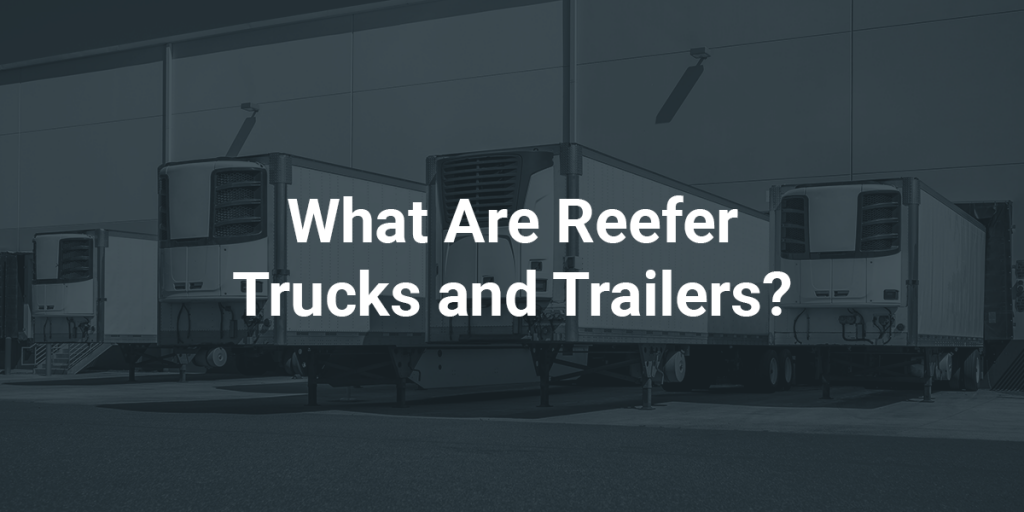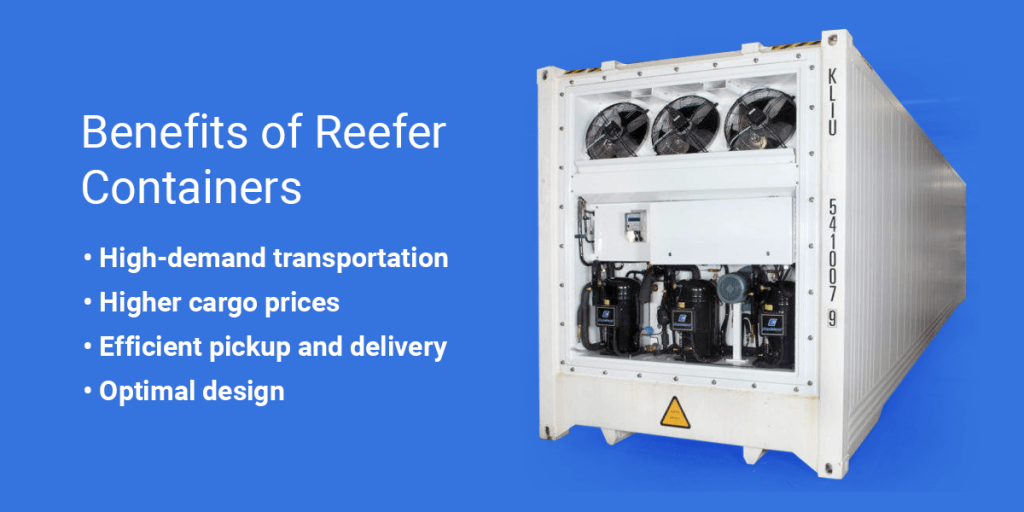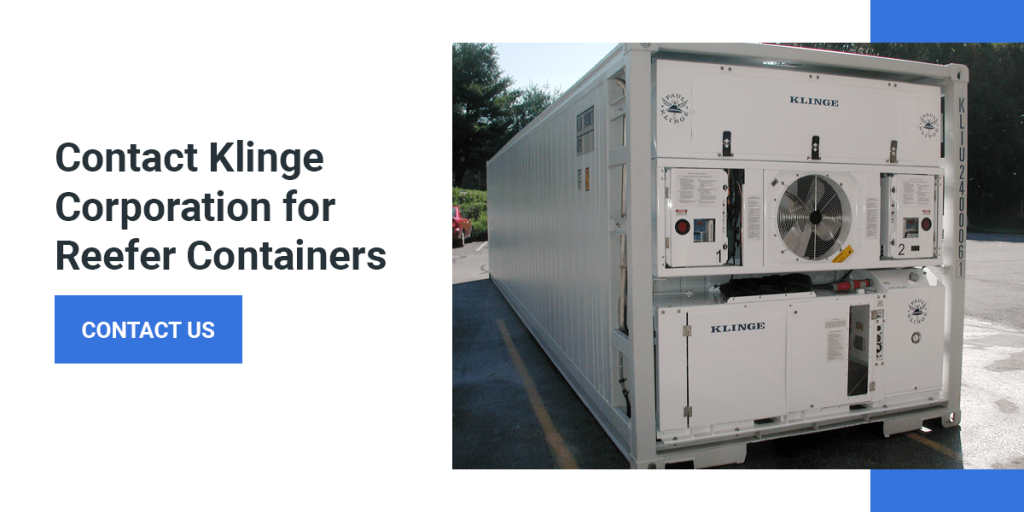
Reefer trailers and trucks maintain temperature, humidity and airflow to keep products like fruit, vegetables and pharmaceuticals from spoiling during shipping and storage. They’re an instrumental part of the cold chain process, in which products are transported from 12°C (54°F) down to -70°C (-94°F). Beyond keeping sensitive products safe during transportation, reefer trucks and trailers also accelerate distribution by eliminating stops at cold chain warehouses. Learn more about reefer trailer dimensions, height, and trailer capacity below.
Beyond use for pharmaceuticals and food, reefer trucks and trailers are also used for the military, oil and gas, chemicals and dangerous goods. Below, we’ll discuss the parts of a reefer trailer and standard reefer trailer dimensions, the benefits of transporting temperature-sensitive goods with a reefer truck and the difference between a reefer truck and a reefer container.
Table of Contents
- Parts of a Reefer Truck or Trailer
- Reefer Trailer Dimensions
- Reefer Containers vs. Reefer Trailers
- Contact Klinge Corporation for Reefer Containers
Parts of a Reefer Truck or Trailer
Reefer trucks and trailers use active rather than passive cooling. They utilize battery- or electric-powered generators to keep goods at a constant temperature and humidity rather than relying on insulated panels to maintain a product at a particular temperature for 96 hours or longer.
The parts of a reefer trailer include the compressor, condenser, evaporator and insulation.
- Compressor: On a truck unit, the compressor often attaches to the engine and uses a small motor or vehicle belt system to power the entire unit by drawing in gaseous refrigerant and compressing it. The gas enters the system as a low-pressure, cool fluid and exits as a high-pressure, hot gas.
- Condenser: After passing through the compressor, the high-pressure gas goes through condenser coils and loses its heat via a fan-based cooling system. The condenser absorbs heat from the cargo section and uses it to form gas once enough heat is absorbed. The gas inside the condenser is condensed and liquidized due to the pressure, leaving as a high-pressure, regular-temperature liquid.
- Expansion valve: The expansion valve is instrumental in the reefer container truck process, as it regulates the refrigerant’s flow throughout the system. When the valve restricts the flow of the refrigerant, the molecules expand and result in a low-pressure, cold liquid.
- Evaporator: The evaporator is located in the truck’s cargo section and changes the low-pressure, cold liquid into a low-temperature, low-pressure gas. The evaporator fan pulls room-temperature air from the cargo department over the evaporator coils and fins to circulate it throughout the trailer. Refrigerant going through the evaporator will boil and change into a gas, as it has a low boiling point. Afterward, the gas returns to the compressor and repeats the process until the system reaches the desired temperature.
- Insulation: A layer of polyurethane foam throughout the entire trailer protects the truck’s interior from the outside environment.
Reefer Trailer Dimensions
While reefer trailer dimensions can vary, standard-sized trucks share several dimensions. Reefer trailers connect to standard semi-trucks to transport sensitive goods.
How Long Is a Reefer Trailer?
The standard length of a reefer trailer is 48 to 53 feet.
How Wide Is a Reefer Trailer?
Reefer trailers are typically 8 feet and 6 inches long. The internal width of the trailer is 8 feet and 1.5 inches.
What Is a Reefer Trailer’s Height?
Standard reefer trailers are typically 13 feet and 6 inches high on a 46.5-inch fifth wheel. The internal height of the reefer trailer is about 8 feet and 7 inches, with a door height of 9 feet and 2 inches.
How Much Does a Reefer Trailer Weigh?
The standard reefer trailer has a tare weight, including tires and wheels, of 12,455 pounds. The unit itself weighs an additional 2,000 pounds. Reefer trailers have a gross vehicle weight rating of 65,000 pounds, while the standard payload capacity is 55,000 pounds.

Reefer Containers vs. Reefer Trailers
While reefer trailers are used for road transportation, reefer containers can transport cargo by road, rail or sea while offering all the same benefits of Reefer Trailers. Reefer containers are crucial for international shipping of delicate products that could go bad in dry containers. Reefer containers are powered by vessel or shore power when transported by ship or with a built-in or portable generator for transportation by rail or truck.
Like reefer trailers, containers have a condenser, an evaporator and a set of interior fans. They also contain fresh air vents, which is especially important for fruit transport by allowing outside air to enter and fruit-ripening gases to leave. Unlike trailers, reefer containers are typically either 20- or 40-feet long and can be easily carried or lifted off of intermodal chassis.
These containers must be appropriately placed to maintain adequate airflow and keep products at the desired temperature. They also have T-floors for airflow underneath, and cold air from the refrigeration unit can flow through these vents. Meanwhile, warm air flows to the top of the cargo and back into the refrigeration unit to be chilled. The entire floor of the container must be covered to ensure this process runs smoothly.
Once a reefer container arrives at its location, a genset or generator set is required for power. Reefer containers can also be used for temporary storage, but they will need a power source to operate the cooling function. Some containers, like those from Klinge, have optional on-board generators for keeping the systems powered at all times.

Contact Klinge Corporation for Reefer Containers
For nearly 40 years, Klinge Corporation has been a global leader in reefer container manufacturing and design for the military, chemical and dangerous goods, meat and seafood processing, pharmaceutical and medical and offshore oil and gas industries. We’ve become a global leader in refrigerated units and ISO containers through our dedication to research, specialized design and quality engineering. We tailor products to your individual needs rather than producing large-scale, standard items.
For more information on our products, such as our container cooling units, tank containers, freezer shipping containers, and pharmaceutical containers, talk to one of our specialists at Klinge Corporation or request a quote to learn more!
